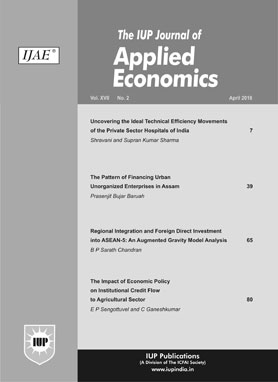
Jan '24
|
|
The IUP Journal of Applied Economics
ISSN: 0972-6861
A "peer-reviewed" journal included in the ABDC List, and also distributed by EBSCO and ProQuest (Part of Clarivate) Database
It is a quarterly journal that analyzes the issues of Micro, Macro, Development and Energy economics. It provides papers on Industrial economics, Public finance, Industry, Agricultural, Rural economics, etc.
| Focus Areas | |
|---|---|
|
|
|
|
|
|
|||
| Article | Price (₹) | ||
| Measuring the Effect of Trade Barriers on Exports Using an Augmented Measure: Evidence from India |
100
|
||
| India's Service Exports to OECD Countries: Evidence on Crowding Out |
100
|
||
| FDI Inflows and Exports of Automobile Industry in India: A Cointegration Approach |
100
|
||
| Predicting Time-Varying Causality Between Inflation Expectations and Realization using ML Technique: Evidence from India |
100
|
||
Measuring the Effect of Trade Barriers on Exports Using an Augmented Measure: Evidence from India
The World Trade Organization's (WTO) policy of free and fair trade has led to persistent decline in the average world trade tariff rates. It also ensured prior ratification of non-tariff measures implemented by countries. At the same time, countries across the world have introduced trade facilitation measures to ensure smooth flow of goods across borders. Despite these, countries still face substantial trade barriers. Against this backdrop, using data from India, the present paper aims at analyzing the impact of trade barriers on its exports by calculating a bilateral trade restrictiveness index based on tariff, non-tariff and border administrative and regulatory measures. The results show that trade restrictions faced by a country depend on its export basket composition, specific export products and its export destinations and hence are unique to each country. They confirm the existence of substantial trade barriers for a country, as against the general perception that trade restrictions have declined over the years.
India's Service Exports to OECD Countries: Evidence on Crowding Out
At the root of the second wake of export pessimism is the argument that export-led growth (ELG) models suffer from a fallacy of composition. Under constrained global demand, all exporting nations cannot simultaneously pursue ELGs, and the ensuing battle for markets would eventually cause more competitive exporters to drive out or displace less competitive ones. Considering how the Indian economy has witnessed a deceleration in her export of services since the mid-2000s, this paper enquires whether similar export-displacements could have lent to this status quo. Using bilateral service trade data for the years 2005-2015, the paper tests the displacement or crowding out of India's export of services to advanced OECD nations by exports from other developing and emerging market economies. Our results show the remarkable presence of complementarity between service exports from India and that from other exporting powerhouses like China, Singapore and Vietnam, though the country appears to have been losing markets for her prime services to certain emerging exporters.
FDI Inflows and Exports of Automobile Industry in India: A Cointegration Approach
The study examines the role of foreign direct investment (FDI) in shaping the export trajectory of the Indian automobile sector. The study uses VECM technique to determine the existence of cointegration between FDI inflows and exports of automobile industry, and to check the long-run and short-run dynamism among the variables. It uses annual time series data on exports and FDI inflows in the industry by considering Indian rupee real effective exchange rate (REER) and world GDP as control variables. The study finds that FDI inflows positively and significantly affect the exports of automobile industry in India in the long run. The findings also validate the J-curve theory of effect of depreciation on the exports of automobile industry that depreciation of Indian rupee has a favorable effect on the exports or trade balance of this industry. The study finds a significant relationship between FDI inflows and exports in only one direction, i.e., running from FDI inflows to exports of the industry. Furthermore, the results show that there is bidirectional causality between India's rupee REER and FDI inflows in automobile industry. The results suggest that providing a conducive environment to foreign players would positively impact the exports of the automobile industry.
Predicting Time-Varying Causality Between Inflation Expectations and Realization using ML Technique: Evidence from India
This study investigates how household inflation expectations relate to realized inflation, and uses biased expectations hypothesis (BEH) to understand the association between inflation expectations and realized inflation in the food sector. Household survey data, wholesale price index (WPI), and consumer price index (CPI)-based data on inflation are used in the study and the data was sourced from the Reserve Bank of India (RBI) and Ministry of Statistics and Program Implementation, Government of India. The obtained results were cross-validated using auto-SARIMAX algorithm in a machine learning (ML) framework. The study finds that expected and realized inflation have significant causal relationships; this further supports BEH and reveals how household inflation expectations impact actual market inflation, and vice versa. Hence, these are broadly complementary. However, changes may occur in these aspects, and households and markets must prepare for these changes and plan their future accordingly.